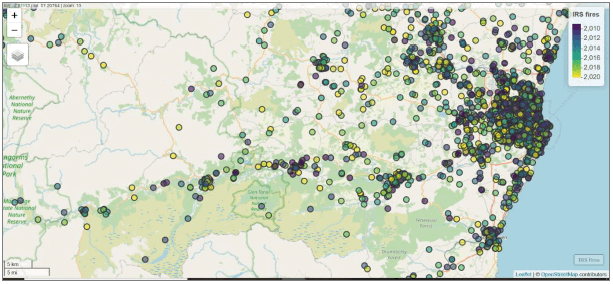Scottish Fire and Rescue Service (SFRS) - wildfire: incident reporting system - data analyses
This report examines Incident Reporting System (IRS) data on wildland fire incidents and uses these to improve the understanding of how upland wildfires start, investigate if wildfire occurrence differs between geographical areas; and describe how wildfires exhibit seasonal and temporal trends.
2 Description of the SFRS IRS dataset
The dataset provided by the Scottish Fire and Rescue Service (SFRS) for the purpose of this project consists of 132,829 recorded fire incidents between April 1st 2009 to December 31st 2020. This is a subset of the Incident Reporting System (IRS) records that has been created by filtering for completed fire incident records based on thirty-one (31) Property Type Level codes/descriptions that denote an Outdoor Fire and likely Wildfire Land Type.
The IRS dataset consists of 44 fields, of which the most relevant to this project are the following:
- Incident Id, which is a unique code for each recorded fire incident.
- Eastings/Northings, which are the coordinates of the location of recorded fire incidents in the OS British Grid.
- Incident Type, which consists of three classes: Outdoor fire (n=87,533); Refuse (n=40,117) and Other Primary Fire (n=5,179).
- Recorded dates of fire incidents.
- Property Type codes denoting burnt vegetation or fuel type, of which information for Level 3 Property Types were mostly used in this project.
- Outdoor Damage Area, which gives an estimate of burnt area (in m2) based on the following classes: None; Up to 5 m2; 6 - 10 m2; 11 - 20 m2; 21 - 50 m2; 51 - 100 m2; 101 - 200 m2; 201 - 500 m2; 501 - 1000 m2; 1,001 – 2,000 m2; 2,001 – 5,000 m2; 5,001 – 10,000 m2 and Over 10,000 m2. Additionally, we also considered field Outdoor Damage Large Area Size, which gives a numeric estimate of the burnt area, but this information was available for only 676 recorded fire incidents.
- Motive, which consists of three classes: Accidental (n=11,002); Deliberate (n=111,819) and Not Known (n=10,008). We also looked at information related to cause of ignition, ignition source and items causing ignition and fire spreading that were available for a subset of recorded fire incidents.
Visual inspection of the spatial distribution of IRS fires using the recorded coordinate information revealed the presence of strong clustering within and/or in proximity of urban areas or other settlements and around the primary and secondary road networks, as shown in Figure 2.1 for the Aberdeen City and Aberdeenshire areas.

Regarding the recorded vegetation or fuel types, around 52% of the recorded fire incidents belong to the Property Type Level 2 category of "Grassland, woodland and crops" and the remaining 48% are found in the "Other outdoors (including land)" category. Table 2.1 provides the counts and overall proportions of fire incidents for each Level 3 Property Type. The greater number of recorded fire incidents (around 30%) belongs to the "Loose refuge incl. in garden" category, while another 4% is found in the "Wasteland" category; both categories are classified as "Other outdoors" fires. Most fire incidents classified as "Grassland, woodland and crops", which are more likely to relate to wildfires affecting seminatural vegetation, are found under the "Grassland, pasture, grazing etc" category (~12%), followed by fires in "Scrub land" (~11%) and in "Heathland or moorland" (~6%).
| A/A | Property Type Level 2 | Property Type Level 3 | Count | Proportion (%) |
|---|---|---|---|---|
| 1 | Grasslands, woodlands, and crops | Canal/riverbank vegetation | 1,910 | 1.44 |
| 2 | Grassland, pasture, grazing etc | 15,697 | 11.82 | |
| 3 | Heathland or moorland | 7,417 | 5.58 | |
| 4 | Hedge | 1,452 | 1.09 | |
| 5 | Nurseries, market garden | 26 | 0.02 | |
| 6 | Private/Domestic garden/allotment (vegetation not equipment/building) | 4,807 | 3.62 | |
| 7 | Railway trackside vegetation | 836 | 0.63 | |
| 8 | Roadside vegetation | 4,789 | 3.61 | |
| 9 | Scrub land | 15,103 | 11.37 | |
| 10 | Stacked/baled crop (incl. manure heap) | 1,010 | 0.76 | |
| 11 | Standing crop | 76 | 0.06 | |
| 12 | Straw/stubble burning | 1,090 | 0.82 | |
| 13 | Tree scrub (includes single trees not in garden) | 11,421 | 8.60 | |
| 14 | Woodland/forest - broadleaf/hardwood | 1,798 | 1.35 | |
| 15 | Woodland/forest - conifers/softwood | 2,017 | 1.52 | |
| 16 | Other outdoors (including land) | Airfield/runway | 3 | 0.00 |
| 17 | Beach | 417 | 0.31 | |
| 18 | Cemetery | 145 | 0.11 | |
| 19 | Cycle path/public footpath/bridleway | 1,711 | 1.29 | |
| 20 | Golf Course (excluding buildings) | 177 | 0.13 | |
| 21 | Highway/road surface/pavement | 1,166 | 0.88 | |
| 22 | Human harm outdoors | 8 | 0.01 | |
| 23 | Lake/pond/reservoir | 27 | 0.02 | |
| 24 | Loose refuse (incl. in garden) | 40,176 | 30.25 | |
| 25 | Other outdoor location | 9,261 | 6.97 | |
| 26 | Park | 3,498 | 2.63 | |
| 27 | Playground (not equipment) or Recreational area | 710 | 0.53 | |
| 28 | Railway | 146 | 0.11 | |
| 29 | River/canal | 138 | 0.10 | |
| 30 | Sea | 5 | 0.00 | |
| 31 | Wasteland | 5,792 | 4.36 |
Contact
Email: alison.seton@gov.scot
There is a problem
Thanks for your feedback